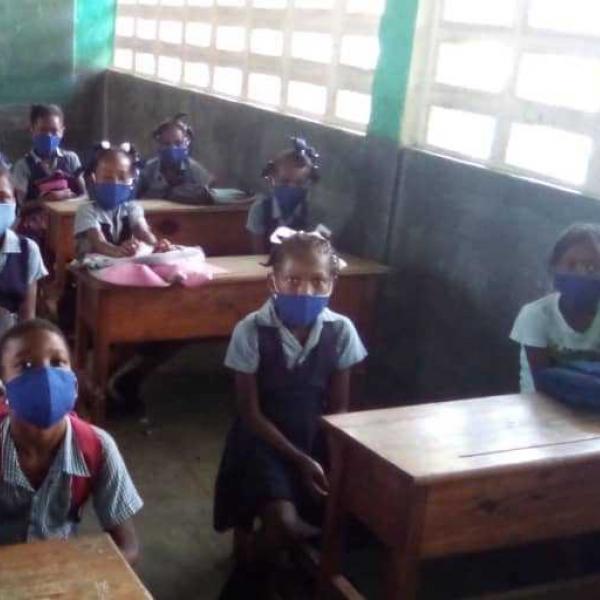Education in Crisis: Can COVID-19 help bridge the Digital Divide?
At its peak, school closures due to COVID-19 occurred in 191 countries, affecting nearly 1.6 billion students and 63 million teachers (UNESCO 2020).
While these numbers are unprecedented, large-scale school closures are not. Every year, nearly 75 million children experience disruptions in their education due to natural disasters, political strife, and disease outbreaks (ODI 2016). Let’s put that in perspective: every year, more children experience disruptions to their education than the total populations of California and Texas combined. While pandemics, conflict, and displacement are often unpredictable, how educational systems respond to them should not be.
The answer to a more resilient education system is creating hybrid learning systems that leverage a variety of methodologies to reach students in a diversity of contexts. This involves a mixture of face-to-face instruction, play-based learning, and e-learning to give learners multiple access points to education. To do so, educators must be creative in how they confront community-specific challenges and bridge the digital divide: the sharp division between those students with reliable access to technology and the internet and those without. If we can document the challenges faced and innovations developed by actors globally in response to school closures, the current crisis offers an opportunity to learn how to create hybrid systems in all settings. We have an important opportunity to create long-term impact to benefit generations of future learners.
The digital divide has long since impacted low-resource countries’ responses to crises that necessitate distance learning. Although e-learning programs are accessible to 90% of stay-at-home learners in the United States, less than 30% of home-based learners in low-income countries benefit from them (Carvalho & Hares 2020). Access to connectivity and technology is the main culprit: globally, half of students do not have a household computer, and 43% have no internet access (UNESCO 2020). The digital divide hits stay-at-home learners in sub-Saharan Africa the hardest, where 89% of households do not have computers, and 82% do not have access to the internet or cellular networks (UNESCO 2020). In Haiti, only 52% of households have radios, let alone smartphones, televisions, and laptops (FinScope Haiti 2018).
But unlike in previous crises, COVID-19 is spurring alternative distance learning responses in rural communities around the globe. WhatsApp, Facebook, radio, television, and learning packets are emerging as alternatives or supplements to e-learning. While teachers use WhatsApp and Facebook to share materials, we also see these platforms used as forums for teachers to gauge student wellbeing and provide support when possible. However, clearly there are limitations to this: using WhatsApp and Facebook to facilitate learning or support relies on possession of a smartphone with good data.
In remote Colombian communities with limited cellular networks, educators develop learning packets with guides that parents collect at local stores. Mountainous communities have designated messengers who, by mule, pick up and deliver the packets.
In Haiti, educators activated the Catholic Radio Network to provide early-grade literacy and socio-emotional skills to housebound students. The program draws from an existing literacy curriculum and incorporates wiggle times, read-alouds, and parent-child activities.
In Kenya, the Institute of Curriculum Development has leveraged pre-existing, tech-based, and curriculum-aligned platforms during the crisis. Dr. Sara Ruto, CEO of the PAL Network, shared how having programs that follow the curriculum is advantageous; however, the material is dull and does not captivate children: “bureaucracy can stifle people, so the question becomes, how can one break up the norm?” Dr. Ruto sees an opportunity for intermediaries to energize the existing programming, making it more engaging and effective. In Kenya, companies, such as Ubongo TV and Akili Kids!, are paving the way with animated, play-based learning modalities and free-to-air television shows that complement existing infrastructures.
COVID-19-prompted partnerships in Haiti may also prove crucial to a hybrid-learning future. Educators are working with internet and tech companies to operationalize a package of learning materials that integrate literacy-based curricula, play-based learning, and ed-tech into a new hybrid-learning system in both times of crisis and normalcy. While it is not feasible to ensure every household has internet access and computers, the potential for hubs in schools and churches, equipped with solar panels and tablets for the facilitation of learning materials, provides a hopeful alternative.
COVID-19 is not an equal opportunity killer: it preys on the most vulnerable segments of society. It has ruthlessly discriminated against student learners on the wrong side of the digital divide and has revealed that a resilient education system must be able to rapidly respond to school closures. The current health crisis has not created the need for these efforts; rather, it has heightened the urgency with which they need to be pursued. Low-and-middle income countries cannot place all of their hope in e-learning: emerging innovations must be documented and used to inform realistic national plans to create hybrid learning structures for all learners. We have an opportunity to seize this moment and diversify resources for learners: we must take it.

